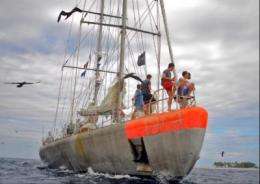TARA OCEANS completes 60,000-mile journey to map marine biodiversity

The two-and-a-half-year TARA OCEANS expedition finishes on 31 March when the ship and crew reach Lorient, France. The arrival completes a journey of 60 000 miles across all the world's major oceans to sample and investigate microorganisms in the largest ecosystem on the planet, reports Eric Karsenti in an editorial published today in Molecular Systems Biology.
"Life and evolution started in the oceans, yet we know very little about the distribution of marine biodiversity," said Karsenti, senior scientist at the European Molecular Biology Laboratory in Heidelberg, Germany, and Co-Director of the TARA OCEANS project. "If it were not for these microorganisms we would not exist. First, we are their evolutionary descendants and second they generate the atmosphere of the Earth."
The scientists taking part in the TARA OCEANS expedition want to understand how the populations of microscopic organisms that make up 98% of life in the oceans interact with the environment and how these complex systems have evolved over time. "It is an interplay between the different species and each species affects the environment," explained Karsenti in a live interview with Molecular Systems Biology. "Oceans are very heterogeneous both geographically and at different depths — each water mass has a different ecosystem."
Recent advances in DNA sequencing and automated microscopy have accelerated the large-scale research needed for this type of project. In addition, the availability of powerful data processing methods makes it possible for scientists to build a global systems biology map of the interactions between the environment and the microorganisms that inhabit the oceans of the world.
The goal of systems biology is to map, understand and model the whole network of interactions that make up life. "Systems biology can be applied at any organizational level of living organisms, from molecular interactions to ecosystems and evolution," remarked Karsenti.
Samples taken from different depths of water provide access to detailed information on the genetic makeup of the marine microorganisms as well as their shape and physical environment. When combined with real-time satellite imaging of the oceans, the vast amounts of data can be used as a starting point to build predictive computational models of the diversity of microorganisms in the ocean as well as their evolution. "We hope to use the data to feed computational models that will describe the evolution of marine ecosystems," said Karsenti.
The project brings back samples from 155 stations taken from all the main oceans on the planet. "After the completion of the ocean voyage and the collection phase of the operation, the land-based investigation is truly picking up speed," concluded Karsenti.
More information: Read the editorial: www.nature.com/msb/journal/v8/ … 1/full/msb20128.html
Listen to the Podcast: www.nature.com/msb/podcasts_videos/index.html
Further information on Molecular Systems Biology is available at www.nature.com/msb
Learn more about the TARA OCEANS expedition: oceans.taraexpeditions.org
Journal information: Molecular Systems Biology
Provided by European Molecular Biology Organization


















